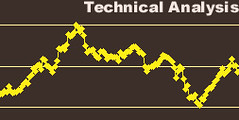Investors generally three kinds of tools: toolbox, black box, and gray box when it comes to computer asistance.
Or as Alexander Elder puts it... "Toolboxes are for serious traders, black boxes are for people who believe in Santa Claus, and gray boxes are in between."
So, which group do you really belong to?
Toolbox has a whole set of tools for you to apply as you wish. A good charting program, for example, with a full complement of drawing tools, markers, flags, trends, as well as full set of technical indicators, RSI, Stochastics, Moving Averages, envelopes and bands, or even write your own, is a toolbox. You choose which tools to apply, and apply the tools your way. The tools do NOT force their views on you. They just process data, spits out some numbers / charts. You decide if they are good signals.
Black box software basicaly gives you the signals, without really explaining why it is recommending a buy. It's like the mythical supercomputer: you feed it some data, push a button, lights blink, then you get an answer. The problem is, markets can and do change. DJIA has changed its members so many times, that most of the companies that DJIA tracked when it was first created no longer exists. Every investment fund has a disclaimer that says "past records is not indicative of future performance". So, even if such a "blackbox" software has impressive track record of predicting ups and downs, will it really continue to be successful in the future? Be honest: the only people making money from Black Boxes are the sellers. Which is why I chuckle when I see those infomercials... "buy when it's green, and sell when it is red!" Frankly, they probably tuned and retuned their "system" until it CAN flag the major ups and downs, and then use those as the example. Will you really make money with it? All those "testimonies" will have the disclaimer at the bottom "results atypical, your results may vary." Just like those fad diet and exercise gear on those infomercials.
Gray box is still proprietary stuff, but at least they explain a bit what is involved. it gives signals, but you can usually "tune" it somewhat. The closer it is to a "toolbox", the better it is.
Nowadays, you can get charts from the Internet easily. Every financial website, from CNNfn to Yahoo! Finance to Google Finance and many more have excellent charting abilities, with various subcharts, as well as access to all sorts of fundamental data like ownership, financials, and more. And programs such as AptiStock (free) will let you do your own graphing offline.
If you want to do your own charting, we have discussed most of commonly used technical indicators and markers you will often need in your toolbox. Remember, new ones are invented all the time and touted as the next "do-it-all" indicator. Also, not all indicators are supported by all packages.
Here is a list: (the not-so-common ones are marked with asterisk *)
Trendlines (both top and bottm)
Markers / Labels
Brackets (for patterns, like head-and-shoulders, and so on)
Slope angle measure
Fibonacci lines (vertical and horizontal) / fan
Channels (different variations)
Gann line / fan
Pitchfork
Cycle Lines
Bollinger Band
* Moving Average Envelope
* Keltner Channel
* Parabolic Stop Reversal (PSAR)
SMA - simple moving average
* VWMA - volume weighted moving average, or just VMA
MACD / Histogram - moving average convergence / divergence
RSI - relative strength index
Stochastic (fast and slow)
Rate of Change (ROC)
ADX - average directional index
* ATR - average true range
OBV - on balance volume
* VOLA - volatility
* MFI - money flow index
CCI - commodity channel index
* VAO - volume accumulation index
* Aroon Oscillator
* Ultimate Oscillator
William %
* Chaikin Oscillator
and many many more
Use the tools, but know what you use it FOR. The more practice you do, the better you'll get.
Keep in mind that I am NOT a big fan of technical analysis, as I consider myself 75% fundamental / 25% technical. I pick stocks with fundmental, but buy/sell with technical. You need to come up with your own system, but you can't have a system without figuring out all the tools first.


![Reblog this post [with Zemanta]](http://img.zemanta.com/reblog_e.png?x-id=f22c77ba-4f92-4099-b241-0e251e5ff2d2)